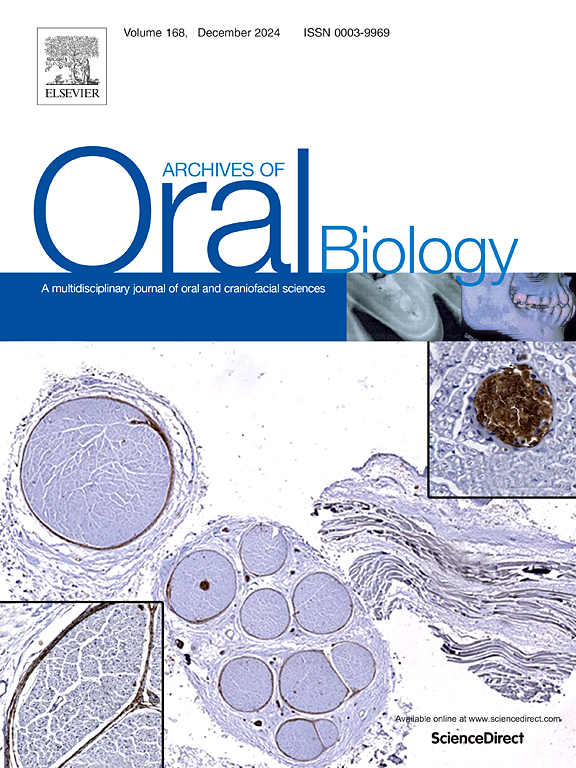Asiatic acid methyl ester是一种新的Asiatic苷衍生物,可诱导hPDLCs成骨分化。
IF 2.2
4区 医学
Q2 DENTISTRY, ORAL SURGERY & MEDICINE
引用次数: 0
摘要
目的:积雪草苷具有通过Wnt (wingless -相关整合位点)信号诱导人牙周韧带细胞(hPDLCs)成骨分化的能力。一个修饰的化学结构(通过去除糖苷侧链),被称为亚洲酸甲酯(AA1),已被构建和评估其诱导成骨分化的能力。设计:采用MTT法测定hpdlc的活力。采用实时荧光定量PCR分析mRNA表达情况。免疫荧光染色证实β-catenin的亚细胞定位。在成骨培养基中培养hpdlc,茜素红染色检测沉积钙。免疫荧光和western blot检测蛋白表达。结果:AA1浓度在50 µM或以下时对hpdlc没有毒性,而积雪草苷在任何浓度下对细胞活力都没有影响。结果表明,2.5 µM AA1和100 µM积雪草苷显著诱导骨和牙本质基质蛋白1 (osterix and dentin matrix protein1, DMP1)基因表达,并伴有矿化结节的形成。AA1激活Wnt信号,表现为WNT3A表达增加和β-catenin核易位。当用重组人Dickkopf1 (rhDKK1)预处理细胞时,这种激活被有效抑制。rhDKK1在mRNA和蛋白水平上显著减弱aa1诱导的DMP1的表达。结论:这些结果证实了积雪草苷和AA1在促进hpdlc成骨分化中具有共同的机制,且AA1的效力更高。总之,本研究介绍了一种新的积雪草苷衍生物,它有可能提高牙周再生的治疗效果。本文章由计算机程序翻译,如有差异,请以英文原文为准。
Asiatic acid methyl ester, a new asiaticoside derivative, induces osteogenic differentiation of hPDLCs
Objective
Asiaticoside has the capacity to induce osteogenic differentiation of human periodontal ligament cells (hPDLCs) through Wnt (Wingless-related integration site) signaling. A modified chemical structure (by removing glycoside side chain), referred to as asiatic acid methyl ester (AA1), has been constructed and evaluated for its capacity to induce osteogenic differentiation.
Design
hPDLCs viability was determined by MTT assay. The mRNA expression were analyzed by using quantitative real time PCR. The subcellular localization of β-catenin was demonstrated by immunofluorescence staining. hPDLCs were cultured in osteogenic medium and the deposited calcium was detected by alizarin red staining. The protein expressions were examined by immunofluorescence and western blot.
Results
AA1 at a concentration 50 µM or below was not toxic to hPDLCs whereas asiaticoside had revealed no impact on cell viability at any concentration tested. The results showed that 2.5 µM of AA1 and 100 µM of asiaticoside significantly induced gene expression of osterix and dentin matrix protein1 (DMP1), concomitant with a formation of mineralized nodules. AA1 activated Wnt signaling as shown by an increase of WNT3A expression and nuclear translocation of β-catenin. This activation was effectively inhibited when cells were pretreated with recombinant human Dickkopf1 (rhDKK1). rhDKK1 significantly attenuated the AA1-induced expression of DMP1 at both mRNA and protein level.
Conclusions
These results confirm a common mechanism between asiaticoside and AA1 in fostering osteogenic differentiation of hPDLCs with a higher potency of AA1. In summary, this study has introduced a novel derivative of asiaticoside, which potentially enhance therapeutic effectiveness for periodontal regeneration.
求助全文
通过发布文献求助,成功后即可免费获取论文全文。
去求助
来源期刊

Archives of oral biology
医学-牙科与口腔外科
CiteScore
5.10
自引率
3.30%
发文量
177
审稿时长
26 days
期刊介绍:
Archives of Oral Biology is an international journal which aims to publish papers of the highest scientific quality in the oral and craniofacial sciences. The journal is particularly interested in research which advances knowledge in the mechanisms of craniofacial development and disease, including:
Cell and molecular biology
Molecular genetics
Immunology
Pathogenesis
Cellular microbiology
Embryology
Syndromology
Forensic dentistry
 求助内容:
求助内容: 应助结果提醒方式:
应助结果提醒方式:


